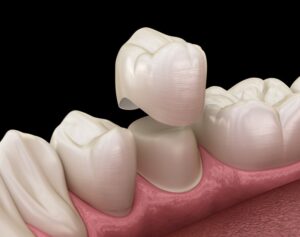
Dental crowns are one of the most common and effective treatments in modern dentistry. They protect damaged teeth, restore function, and create beautiful, natural-looking smiles. But did you know that dental crowns have been around for thousands of years? The journey from primitive gold caps to today’s high-tech ceramic restorations is a fascinating story of innovation and artistry. Let’s take a look at the history of dental crowns and how they’ve evolved through the ages.
Ancient Beginnings: Gold, Ivory, and Bones
The concept of protecting or replacing teeth isn’t new. Archaeologists have found evidence of dental crowns dating back to 200 A.D. in ancient civilizations like the Etruscans — a people who lived in what is now Italy. The Etruscans were known for their advanced craftsmanship, and they used gold bands and wires to hold replacement teeth in place. These early crowns not only restored function but also reflected wealth and status, as gold was a symbol of prestige.
In other parts of the world, early forms of dental restorations were made from ivory, animal bones, or seashells, often held in place with simple adhesives or metal wires. While far from perfect, these early efforts showed humanity’s desire to restore both the look and function of lost or damaged teeth.
The Middle Ages: Dentistry’s Dark Period
During the Middle Ages, dental care regressed significantly. Tooth extractions were the most common treatment, often performed by barbers or blacksmiths rather than trained professionals. Crowns and restorative techniques became rare, and most people simply lived with missing or decayed teeth.
However, by the 1700s, dental science began to re-emerge in Europe. Gold and metal were once again used to cap damaged teeth, laying the foundation for the restorative dentistry we know today.
The 19th Century: The Birth of Modern Dentistry
The 1800s marked a turning point in dental restoration. With advances in materials and techniques, dentists began using porcelain fused to metal to create crowns that looked more natural.
In 1889, Dr. Charles H. Land revolutionized dentistry by patenting the first porcelain jacket crown. This innovation allowed for a more aesthetic option than gold alone, as porcelain could mimic the natural color of teeth. Land’s invention is widely regarded as the ancestor of modern all-ceramic crowns, and it quickly became popular among patients who wanted both durability and beauty.
The 20th Century: Stronger, Smarter, and More Aesthetic
Throughout the 20th century, dental crowns continued to evolve. Dentists began using porcelain-fused-to-metal (PFM) crowns, which combined the strength of metal with the lifelike appearance of porcelain. This design offered the best of both worlds — durability and aesthetics — and became the standard for decades.
By the late 20th century, advances in ceramic and composite materials led to the development of all-ceramic crowns, which were not only strong but also indistinguishable from natural teeth.
Today’s Crowns: Precision and Perfection
Modern crowns are a blend of art and technology. With the help of digital scanning, CAD/CAM technology, and materials like zirconia and lithium disilicate (E.max), dentists can now design crowns that fit precisely and last for many years.
These crowns are custom-milled for each patient, offering unmatched comfort, color matching, and strength. Some can even be created and placed in a single dental visit using advanced chairside systems.
The history of dental crowns reflects humanity’s continuous pursuit of comfort, beauty, and health. What started as simple gold caps has transformed into a sophisticated dental restoration that combines science, technology, and artistry. Today, dental crowns not only protect your teeth — they help you smile with confidence, carrying forward a tradition that began thousands of years ago.
About the Author
Dr. Robert Saphner earned his dental degree from the University of Minnesota. To date, he has completed over 500 hours of continuing education, has a dental implant fellowship, and holds Fellowship status in the Academy of General Dentistry. Today, Dr. Saphner stays current in his field through memberships in the American Dental Association and the Wisconsin Dental Association. Have a tooth that needs repairing? We can help with dental crowns! Schedule an appointment online or call our La Crosse office at (608) 668-6415.

